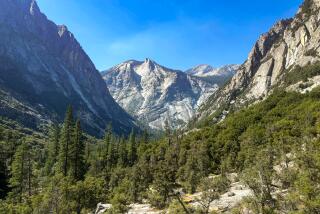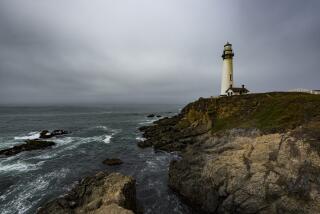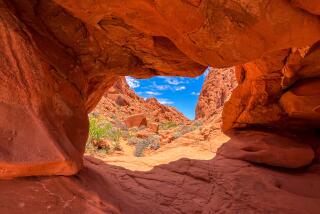Utah gem amid precious stones
- Share via
St. George, Utah — ZION. Bryce. Capitol Reef. The North Rim.
What about St. George? Just a spot to refuel the kids and the car on the way to those magical kingdoms of chasm and red rock.
But after decades of passing through, I made the high-desert town in southern Utah my destination in April. As it turns out, I should have done it long ago.
St. George is ringed by black lava flows, crimson sandstone bluffs and faraway pine-clad mountains. Nearly 70,000 people now call it home (or a second home), more than a few of them Californians attracted by its lung-clearing, mind-relaxing wide-open spaces.
On our first morning here, the late-spring air verily snapped as Michelin Man clouds ambled overhead. My wife, Terri, and I are situational hikers, which means we’re as lazy as Labs at home but eager to paw dust and rock out on the road. We headed immediately to Snow Canyon.
Perish any images of ski resorts. Even in winter, the white stuff is a rarity. Snow Canyon, named after Lorenzo and Erastus Snow, pioneering Mormons with a cold-season surname, is a whole lot of Western wonders in one handy-size state park just minutes outside town. Fire-hued rock? Got it. Sculptured canyons? Uh-huh. Petrified stuff? Check. The obligatory backdrop for horse operas? Well, Robert Redford seems to have spent some time shooting here -- including “Butch Cassidy and the Sundance Kid” and “Jeremiah Johnson.”
We started on the Whiterocks Trail/Lava Flow Overlook, a “moderate” four-miler out and back. (We found the rangers overly cautious when ranking hikes.) About half a mile in, big billows of black broke the surface: lava in a sea of sandstone. The frozen rock was a sharp -- literal, figurative -- contrast to the chalk, canary and vermilion striations of the former lake bottom.
The trail forked, with one tine heading down into a sandy-bottomed, high-walled canyon. The path Robert Frost would have advised taking turned northward and climbed gently through pinyon and junipers groaning under loads of berries. A shoulder of rock threatened our progress, but we scrambled up and over and, not far beyond, reached a natural band shell the color of drying plaster.
The Whiterocks Trail is one of about a dozen that fan out through the park heading to dunes, eroded cisterns, a small slot canyon, or about 200 technical climbing routes for those who think hiking should be vertical. A gentle, six-mile paved trail opens the canyon to walkers, in-line skaters and bikers of all abilities.
Just off the southerly portal to Snow Canyon State Park is Tuacahn Center for the Arts, a 2,000-seat amphitheater for concerts and live theater (“Peter Pan” and “Cats” are on tap this summer) suspended within a red-rock canyon.
We hit a home run with “Damn Yankees,” the Faust-meets-baseball classic, which was playing at the St. George Musical Theater. Regular folks run the joint, build the sets, sell the tickets and don the costumes. A few dance steps missed here, a note off there; the audience cared not, and the joy of the craft was evident in each performer.
*
The hub of ‘Dixie’
ST. GEORGE was founded during the Civil War by hardy missionary pioneers set forth from the Salt Lake basin by Brigham Young, who headed the Mormon Church from 1847 to 1877. It’s the hub of Utah’s “Dixie” -- so-called because those first settlers came to plant cotton and other warmer-weather crops, taking advantage of the Virgin River Valley’s unusually temperate climate.
Young spent the last winters of his life in St. George, his health, too, benefiting from the climate. That made him -- as we were told several times during our stay -- St. George’s first snowbird.
Exposed adobe walls, low transoms and steep and narrow stairs mark the original home that Young purchased. Over several years, a more refined structure was appended, ample in glass and pine with grain painted on by hand to simulate better hardwood. It also has an ingenious system to vent smoke from the lamps and a wraparound second-floor balcony from which he accepted the adulation of the community on his 75th birthday.
The previous day, we had toured the stone-and-timber abode of Jacob Hamblin, one of the pioneers Young sent south. Terri commented that the Food Network’s Rachael Ray would lose her giggle if asked to cook “30 Minute Meals” under a similar setup of open hearth and firewood.
Both homes are notable for what they aren’t: Monticello, Mount Vernon or other paean-to-democracy palaces of the East. These are apt, functional homes of the frontier. Young’s is more distinguished and urbane, as befits the president and prophet of the Church of Jesus Christ of Latter-day Saints. Hamblin’s is ramshackle and set along the Santa Clara River several miles west of town, the home of a pathfinder.
From the Young home, we weaved a circuitous path through St. George. Cater-corner from Young’s digs is a house from 1873 that now operates as the Seven Wives Inn, where polygamist fugitives were given haven in the attic after the U.S. banned the practice in 1882. The stone blocks of the St. George Tabernacle were hand-chiseled, the marks of each craftsman visible and distinctive. They’re a deeper red than those quarried for the neighboring St. George Art Center, a onetime academy, high school and college.
A clamor must have accompanied the first stages of construction of the larger St. George Temple (inside of which only Mormons are allowed). A Napoleonic war cannon was used as a pile driver -- raised and dropped, raised and dropped -- to pound volcanic rock into the boggy ground to provide stability. The temple also is made of red sandstone but plastered white. For the jail, builders used lava rock, cut into blocks that were stacked and mortared.
Such 19th century sites pass for ancient history in much of the West, but the last stop during our long weekend was like a trip through Mr. Peabody’s WABAC Machine.
“Swim marks,” a docent said as I stared at the wavy lines in the slab of rock. “Dinosaur swim marks.”
Long before Latter-day Saints, American trappers, Spanish explorers, Native Americans or mastodons, much of “Dixie” was a lake, and it was quite popular with the likes of Protosuchus, Megapnosaurus and some really old garfish.
And swimming dinosaurs.
The St. George Dinosaur Discovery Site at Johnson Farm is a museum and research facility chock-full of footprints, tracks, casts and remains of fish, dinosaurs and crocodilians from the Lower Jurassic, about 200 million years ago. Working the site in February 2000, landowner Sheldon Johnson upturned some sandstone and, voila, a paleontologist’s winning Lotto ticket.
It’s not the Smithsonian, but this city-run operation shows a lot of vision, and there supposedly is no other place in the world to see as many marks left by swimming dinosaurs.
So I guess that means St. George’s first vacationers came long before us.
*
(BEGIN TEXT OF INFOBOX)
Stay a spell
GETTING THERE:
St. George is 390 miles from Los Angeles, about two hours beyond Las Vegas on Interstate 15. There are nonstop flights to St. George’s airport from LAX on United; restricted round-trip fares start at $204.
WHERE TO STAY:
Seven Wives Inn, 217 N. 100 West, St. George; (800) 600-3737, www.sevenwivesinn.com. Period decor B&B; with 13 rooms and suites. Doubles $90-$185.
Red Mountain Spa, 1275 E. Red Mountain Circle, Ivins; (800) 407-3002, www.redmountainspa.com. One of the toniest places to bunk in the area, with a full-service spa and outstanding views. Starting at $229 per person per night, including all meals.
WHERE TO EAT:
The Painted Pony, 2 W. St. George Blvd., No. 22, St. George; (435) 634-1700, www.painted-pony.com. Chef Randall Richards’ fare is fresh, seasonal and decidedly Southwestern -- smoked fowl, lamb, rib steaks. Lunch $8-$11, dinner entrees $18-$26.
Dammeron Valley Barbeque, 1090 N. Highway 18, Dammeron Valley; (435) 574-3600. About 20 miles northwest of St. George, the barbecue is Memphis-grade. Lunch platters $7-$10, dinners $15-$20.
WHAT TO DO:
Snow Canyon State Park, 1002 Snow Canyon Drive, Ivins; (435) 628-2255, (800) 322-3770 www.stateparks.utah.gov. $5 per vehicle entry fee. Overnight camping ($14-$17) in designated areas.
Tuacahn Center for the Arts, 1100 Tuacahn Drive, Ivins; (800) 746-9882, www.tuacahn.org. Tickets $12.50-$44.
St. George Musical Theater, 37 S. 100 West; (435) 628-8755, www.sgmt.org. Tickets $10-$15.
Dinosaur Discovery Site at Johnson Farm, 2180 E. Riverside Drive; (435) 574-3466, www.dinotrax.com. $3 adults, $2 age 4-11, free for kids 3 and younger.
TO LEARN MORE:
St. George Area Chamber of Commerce, 97 E. St. George Blvd.; (435) 628-1658, www.stgeorgechamber.com.
-- Ken Van Vechten
More to Read
Sign up for The Wild
We’ll help you find the best places to hike, bike and run, as well as the perfect silent spots for meditation and yoga.
You may occasionally receive promotional content from the Los Angeles Times.






